近视归正镜说明书
ZEISS PRESBYOND 激光混合视力矫正手册说明书
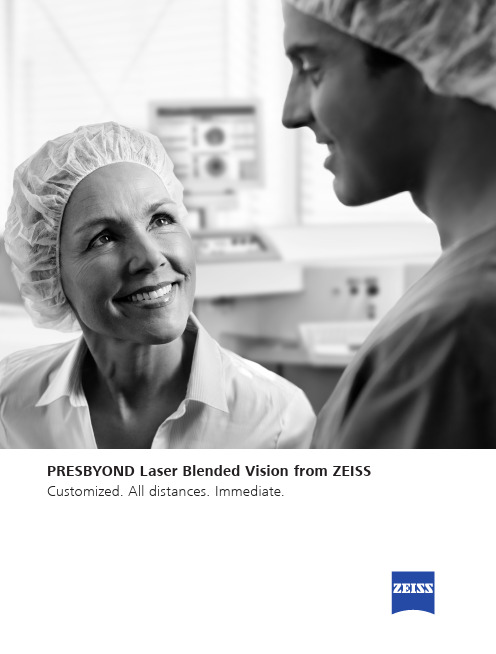
Customized. All distances. Immediate.* I n r e f e r e n c e t o c l i n i c a l o u t c o m e s a s c o m p a r e d t o m o n o v i s i o n . D a t a o n f i l e .Blending vision into better outcomes *.ZEISS PRESBYOND Laser Blended VisionZEISS PRESBYOND Laser Blended Vision A clear choice for patients with presbyopiaPRESBYOND ® Laser Blended Vision from ZEISS is an advanced method for treatingpatients with age-related loss of accommodation, also known as presbyopia. It offers the opportunity to achieve freedom from glasses by combining the simplicity and accuracy of corneal refractive surgery with the benefits of increased depth of field in retaining visual quality. As a surgical solution based on the naturally occurring spherical aberrations of the eye, this ZEISS software extends the scope of customized ablation beyond the limits of conventional monovision laser methods in several ways.Whether for its customized treatment profiles, its visual acuity at all distances, its indications range or its immediate impact, ZEISS PRESBYOND Laser Blended Vision is a clear treatment choice for the fast growing demographic of patients with presbyopia.ZEISS PRESBYOND Laser Blended Vision Customized. All distances. Immediate.ZEISS PRESBYOND Laser Blended Vision lets you greatly expand your ZEISS MEL ® 80 or MEL 90 excimer laser treatmentrepertoire and your patient base354Conventional monovisionWith conventional monovision treatment methods, the dominant eye is corrected for distance vision to almost plano while the non-dominant eye is corrected for near vision, usually up to -3.0 D. Optimal vision is achieved at distance and near range, requiring the brain to contend with two separate images at different levels of correction which not all patients cantolerate.Patients that do tolerate the method are left with an uncorrected gap in the intermediate range, the so-called “Blur Zone.” In addition to the fuzzy image, it can also cause other side effects such as reduced contrast sensitivity and stereoacuity.ZEISS PRESBYOND Laser Blended Vision As a physiologically optimized laser treatment method for patients with presbyopia, ZEISS PRESBYOND Laser Blended Vision represents the next stage in eye care excellence. Similar to conventional monovision, the dominant eye is corrected for distance vision to almost plano, whereas the non-dominant eye is corrected to be slightly myopic for near vision to -1.5 D. This micro-monovision strategy is further enhanced by a decisive difference: an increase in the depth of field of each eye using a wavefront-optimized ablation profile to create a continuous refractive power gradient for the whole optical zone of the cornea. This ZEISS software is an absolutely individualized treatment plan based on the preoperative spherical aberrations and the functional age of the eye. As a result, a customized fusion of the two images for near and distance vision is created for each patient – the so-called “Blend Zone.”Although similar to conventional monovision laser methods in terms of the workflow, ZEISS PRESBYOND ® Laser Blended Vision takes customized vision correction a step beyond, particularly with respect to the outcomes.Next-level vision correction beyond conventional monovisionThe unique Blend ZoneEssentially, the Blend Zone makes it easier for the brain to merge the images of both eyes, thereby achieving true binocular vision. In addition to excellent near and far vision, ZEISS PRESBYOND Laser Blended Vision patients also experience very good visual acuity and contrast sensitivity in the intermediate range.No increase in depth of fieldDominant eye±0.0 DNon-dominant eyeup to -3.0 DDISTANCEIncrease in depth of fieldIncrease in depth of fieldDominant eye±0.0 DNon-dominant eye-1.5 DNEARDISTANCENEAR67All distancesCustomizedImmediateOptimizing outcomes for patients with presbyopiaZEISS PRESBYOND Laser Blended VisionIndividualized ablationsZEISS PRESBYOND ® Laser Blended Vision is a truly customized solution for treating presbyopic patients. It incorporates preoperative wavefront data to fine-tune the depth of field for each eye individually. The functional age of the eye is also factored in. As a result, a personalized ablation profile is created per eye for optimized target refraction. The monovision component can be pre-adjusted for the patient’s tolerance level. Also, different optical zone sizes can be selected to account for the patient’s pupil size.Ideal for a growing demographic As an optimized laser method for age-related accommodation loss, ZEISS PRESBYOND Laser Blended Vision is ideally suited for serving the needs of patients 40-60 years of age – a fast-growing demographic group interested in sophisticated options. It is also one of the least invasive methods for addressing this target group.Familiar procedureFollowing the same workflow as conventional LASIK procedures, ZEISS PRESBYOND Laser Blended Vision combines the convenient binocular treatment planning of the CRS-Master ® with the proven comfort and workflow of the MEL ® 80 or MEL 90 excimer laser, all from ZEISS.Outstanding visual acuityBy customizing each eye individually,ZEISS PRESBYOND Laser Blended Vision provides excellent visual acuity for near and distance vision. Unlike traditional monovision methods, PRESBYOND Laser Blended Vision also offers good intermediate vision in the Blend Zone. According to clinical studies, there is virtually no loss of contrast sensitivity while stereoacuity is maintained. Also, side effects such as multiple images in one eye are almost eliminated.An all-natural approachZEISS PRESBYOND Laser Blended Vision is a physiologically optimized solution and a true binocular method for treating patients with presbyopia.Wide indication rangeZEISS PRESBYOND Laser Blended Vision is a proven and effective method for treating indications ranging from -8.0 D to +2.0 D, includingemmetropic and astigmatic patients (up to +2.0 cyl).Appropriate for most patientsA key advantage of ZEISS PRESBYOND Laser Blended Vision is that it is proven to be tolerated by more patients than conventional monovision. It is effective for treating up to 97% of all presbyopia-related forms of impairment as compared to only 59–67% for conventional monovision. Even patients with presbyopia also affected by emmetropia and astigmatism can be treated. In fact, it has the potential to achieve a far greater success rate than any comparable treatment along with giving patients the wow effect of being able to read without glasses the very same day. Thus, it positively impacts patients and refractive surgeons alike – visually for the former, economically for the latter.1-5 A competitive edgeZEISS PRESBYOND Laser Blended Vision allows practices already using a MEL 80 or MEL 90 excimer laser and CRS-Master from ZEISS to significantly expand their LASIK repertoire and increase the patient base. As such, this ZEISS software offers a decisive competitive advantage over other LASIK practices only specializing in monovision treatment methods.MEL 80 and MEL 90 from ZEISSType ArF excimer laser Wavelength 193 nmFrequency MEL 80: 250 HzMEL 90: FLEXIQUENCE ® 250 Hz / 500 Hz Dimensions (W x D x H)MEL 80:1550 mm x 800 mm x 1490 mmMEL 80 with patient supporting system: 3140 mm x 1800 mm x 1490 mm MEL 90:1360 mm x 730 mm x 1480 - 1700 mm MEL 90 with patient supporting system: 3230 mm x 2380 mm x 1700 mmSurgical microscope OPMI ® pico from ZEISS with integratedHD video camera Active eye trackerInfrared, pupil and limbus tracking, 1050 frames per second (fps), manual ablation center selection, automatic Pupil Center Shift Correction Beam dimensions0.7 mm FWHM (full width at half maximum), Gaussian beam profileVisuMax from ZEISSSystem components Patient supporting system, including platformIntegrated uninterruptible power supply (UPS)Surgical microscope with additional slit illumination Video camera with integrated recording Femtosecond laser parametersWavelength 1043 nm Laser pulse rate 500 kHzRecommended space requirements 180° setup with MEL 80 / MEL 90:4500 x 3800 mm90° setup with MEL 80 / MEL 90:4000 x 4000 mm89A perfect combination:The refractive system landscape of ZEISSTechnical dataDimensions (W x D x H)Max. 1060 x 420 x 1510 mmData transfer USB flash memory drive (USB memory stick)Data printoutVia network connection with Ethernet cable and optional network isolatorReferencesClaims made in this document are supported by information provided in the following publications:1. Reinstein DZ, Couch DG, Archer TJ. LASIK for Hyperopic Astigmatism and Presbyopia Using Micro-monovision With the Carl Zeiss Meditec MEL 80. J Refract Surg. 2009;25(1):37-58.2. Reinstein DZ, Archer TJ, Gobbe M. LASIK for Myopic Astigmatism and Presbyopia Using Non-Linear Aspheric Micro-Monovision with the Carl Zeiss Meditec MEL 80 Platform. J Refract Surg. 2011;27(1):23-37.3. Reinstein DZ, Carp GI, Archer TJ, Gobbe M. LASIK for the correction of presbyopia in emmetropic patients using aspheric ablation profiles and a micro-monovision protocol with the Carl Zeiss Meditec MEL 80 and VisuMax. J Refract Surg. 2012 [In Press].4. Reinstein DZ, Archer TJ, Gobbe M. Stereoacuity after Corneal Presbyopic LASIK in Myopic, Hyperopic and Emmetropic Patients. ESCRS Annual Meeting, Vienna, September 2011.5. Evans BJ. Monovision: a review. Ophthalmic Physiol Opt. 2007;27(5):417-439.CRS-Master from ZEISSSimple upgradePRESBYOND ® Laser Blended Vision is an optional software upgrade for the CRS-Master ® from ZEISS. It forms a perfect fit with the ZEISS MEL ® 80 or MEL 90 excimer laser, expanding the repertoire of customized refractive laser corrections far beyond the limits of conventional monovision methods.PRESBYOND Laser Blended Vision and CRS-Master from ZEISS are not intended for sale in the United States.Laser warning sign MEL 80/90Laser warning sign VisuMaxPrecise flapsThe ZEISS VisuMax ® creates flaps of a highly predictable thickness and of adjustable geometries for Femto-LASIK and ZEISS PRESBYOND Laser Blended Vision – the recommended treatment option for patients with presbyopia.Carl Zeiss Meditec AG Goeschwitzer Strasse 51–52 07745 JenaGermany/contacts /presbyond EN_34_1_3IIIPrintedinGermanyCZ-IX/217Thecontentsofthebrochuremaydifferfromthecurrentstatusofapprovaloftheproductorserviceofferinginyourcountry.Pleasecontactourregionalrepresentativesformoreinformation.Subjecttochangesindesignandscopeofdeliveryandduetoongoingtechnicaldevelopment.PRESBYOND,CRS-Master,MELandVisuMaxareeithertrademarksorregisteredtrademarksofCarlZeissMeditecAGorothercompaniesoftheZEISSGroup.©CarlZeissMeditecAG,217.Allrightsreserved.0297。
角膜塑形镜使用说明书 (3)
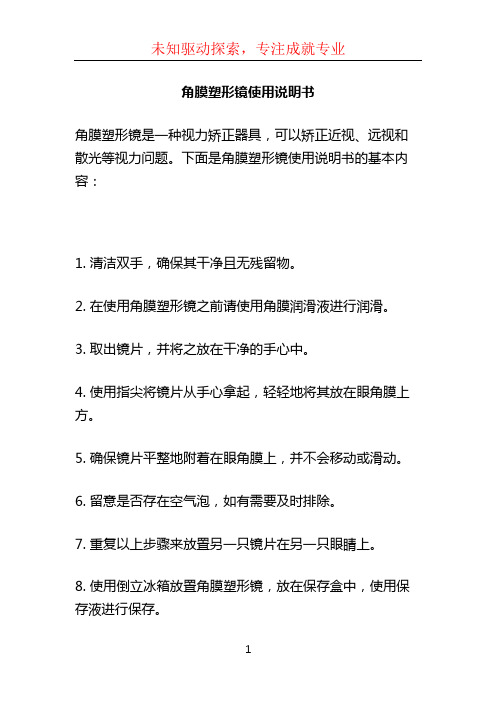
角膜塑形镜使用说明书
角膜塑形镜是一种视力矫正器具,可以矫正近视、远视和散光等视力问题。
下面是角膜塑形镜使用说明书的基本内容:
1. 清洁双手,确保其干净且无残留物。
2. 在使用角膜塑形镜之前请使用角膜润滑液进行润滑。
3. 取出镜片,并将之放在干净的手心中。
4. 使用指尖将镜片从手心拿起,轻轻地将其放在眼角膜上方。
5. 确保镜片平整地附着在眼角膜上,并不会移动或滑动。
6. 留意是否存在空气泡,如有需要及时排除。
7. 重复以上步骤来放置另一只镜片在另一只眼睛上。
8. 使用倒立冰箱放置角膜塑形镜,放在保存盒中,使用保存液进行保存。
9. 每天早上取出角膜塑形镜,并使用角膜润滑液将其清洗
干净。
10. 每天使用前请先进行视力检查,以确保角膜塑形镜仍然适合您的视力矫正需求。
11. 根据您的眼睛专业人员或医生的建议进行日常使用时间,以避免眼睛疲劳或不适。
12. 如有任何不适或不正常症状出现,请立即停止使用,并咨询眼科专业人员或医生的建议。
请注意,以上只是一般的使用说明,具体的使用方法和注
意事项可能会因产品型号和个人情况而有所不同。
在使用
角膜塑形镜之前,最好是咨询眼科专业人士的意见和建议。
近视复健训练镜说明书
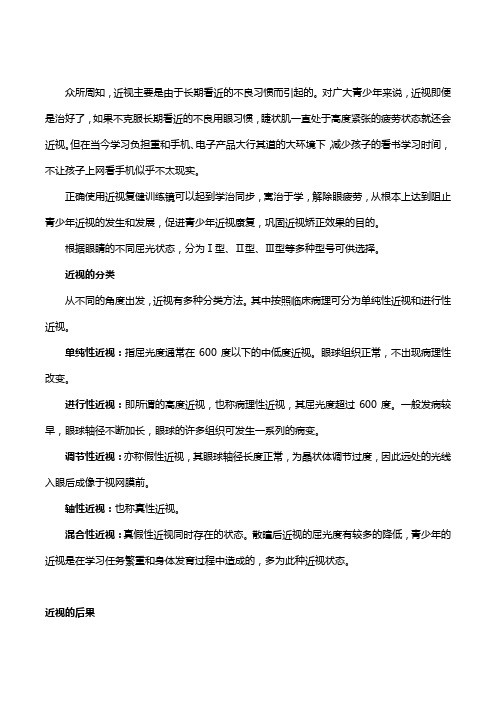
众所周知,近视主要是由于长期看近的不良习惯而引起的。
对广大青少年来说,近视即便是治好了,如果不克服长期看近的不良用眼习惯,睫状肌一直处于高度紧张的疲劳状态就还会近视。
但在当今学习负担重和手机、电子产品大行其道的大环境下,减少孩子的看书学习时间,不让孩子上网看手机似乎不太现实。
正确使用近视复健训练镜可以起到学治同步,寓治于学,解除眼疲劳,从根本上达到阻止青少年近视的发生和发展,促进青少年近视康复,巩固近视矫正效果的目的。
根据眼睛的不同屈光状态,分为Ⅰ型、Ⅱ型、Ⅲ型等多种型号可供选择。
近视的分类从不同的角度出发,近视有多种分类方法。
其中按照临床病理可分为单纯性近视和进行性近视。
单纯性近视:指屈光度通常在600度以下的中低度近视。
眼球组织正常,不出现病理性改变。
进行性近视:即所谓的高度近视,也称病理性近视,其屈光度超过600度。
一般发病较早,眼球轴径不断加长,眼球的许多组织可发生一系列的病变。
调节性近视:亦称假性近视,其眼球轴径长度正常,为晶状体调节过度,因此远处的光线入眼后成像于视网膜前。
轴性近视:也称真性近视。
混合性近视:真假性近视同时存在的状态。
散曈后近视的屈光度有较多的降低,青少年的近视是在学习任务繁重和身体发育过程中造成的,多为此种近视状态。
近视的后果近视眼除了给生活带来诸多不便以外,还有更多的麻烦。
1、近视后并不是戴上眼镜就可以了,度数会随着年级的发展、学习任务的加重而不断的增高。
2、当近视的度数从刚开始的100~200度,发展到600度以上时,可能会出现相应的并发症,如眼底病变,视网膜出血或脱离等恶性情况。
3、随着近视镜片的加深,可能会造成视近困难,过度视疲劳,视物模糊等现象,并导致头晕头痛、眼球酸胀、眼干症等非常麻烦的情况。
4、近视发展为高度以后,很多专业和工作将会受限,并可能遗传。
5、近视眼镜不断破坏视觉神经对眼球调整完毕后的平衡状态,从而使近视患者产生新的真假性近视并存的状态,并不断促使假性近视转化为真性近视。
1.5视力恢复仪使用说明

1.5视力恢复仪使用说明书物品清单(1)1.5视力恢复仪主机1台(2)外置交流电源1个(3)使用说明书1份(4)保修卡1张(5)合格证1张仪器功能结构指示图橡胶带(可调节)针炙强度调节波轮合像/针炙按键LED电子显示屏充电孔充电/复位指示灯弱视/频闪按键眼罩(可摘下清洗)鼻托(可摘下清洗)穴位刺激点观察孔(可根据双眼距离调节宽度)使用步骤(1)使用前应先检查仪器外观是否清洁,各部分按键是否工作正常。
(2)开机必须保证仪器侧面“强度调节拨轮”调节至off位置。
(提示:开机后,如果“强度调节拨轮”事先没有调到off键,主机不会有数码针灸输出,必须将“强度调节拨轮”关闭后,重新打开,才能进入数码针灸模式。
)(3)调整身姿,正确佩戴1.5视力恢复仪。
(4)打开设定程序,按下“合像∕针灸”功能键,此时需眼睛紧贴观察孔、集中注意力努力看清仪器中的移动光标灯。
其间如出现观察孔起雾或蒸气模糊的情况,需用眼镜布及时擦拭干净再继续训练。
(5)5分钟后,光标灯自然熄灭,合像训练结束,打开仪器右侧off键,仪器将会在“滴”的一声后启动“针灸功能”(如果仪器连续“滴”数声,则是警示电池已经亏电,此时需充电后再使用“针灸功能”),按照箭头方向缓慢调节拨轮,当调节拨轮开始之后须缓慢,直至调节针灸脉冲强度大小到使用者感觉合适为止。
此过程需闭上双眼,尽量放松眼睛。
(6)10分钟后,针灸功能结束,仪器将自然关闭,此时再次将仪器右侧的针灸强度调节波轮拨回off处。
(7)使用后需闭目休息5—10分钟,然后尽量多看远方景物。
(8)试用次数及测试视力:使用本产品后做睫状肌恢复训练时,建议早晚每天坚持使用仪器不少于2次、最多不超过3次,以免加重眼睛负担。
训练期内每隔15天可以测一次视力,并且做好记录,同步及时减少眼镜镜片度数,以促进视力恢复。
(9)视近视度数,假性及中轻度近视一个疗程须坚持8-12周,重度近视建议使用半年以上效果更佳。
(10)“弱视频闪”键,开启光谱频闪功能,每按一下,加快闪动一档,共5档(调节频闪开关,直到满意为止),主要用于弱视恢复,一个疗程5分钟后自动关闭。
奥通科技近回归镜参数
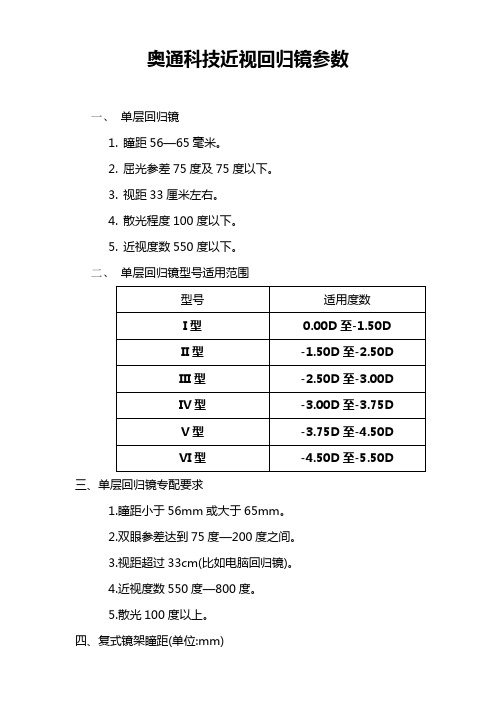
奥通科技近视回归镜参数
一、单层回归镜
1.瞳距56—65毫米。
2.屈光参差75度及75度以下。
3.视距33厘米左右。
4.散光程度100度以下。
5.近视度数550度以下。
二、单层回归镜型号适用范围
三、单层回归镜专配要求
1.瞳距小于56mm或大于65mm。
2.双眼参差达到75度—200度之间。
3.视距超过33cm(比如电脑回归镜)。
4.近视度数550度—800度。
5.散光100度以上。
四、复式镜架瞳距(单位:mm)
正常PD:64 小瞳正常PD:62
大方PD:70 小瞳大方PD:65
椭圆PD:64 小瞳椭圆PD:62
五、老视舒目镜
老视度数型号适用范围
+1.00D 1型+0.50至+1.00D
+1.50D 2型+1.25至+1.50D
+2.00D 3型+1.75至+2.00D
+2.50D 4型+2.25至+2.50D
+3.00D 5型+2.75至+3.00D
+3.50D 6型+3.25至+3.50D
+4.00D 7型+3.75至+4.00D
感谢您对回归镜一直以来的支持!“扫一扫”关注近视回归镜微信公众号,让您更多了解视光知识、回归镜相关产品等更多专业内容。
帮助您及家人远离视力困扰,还您清晰视界。
Tasco 3×17 双眼镜用户指南说明书
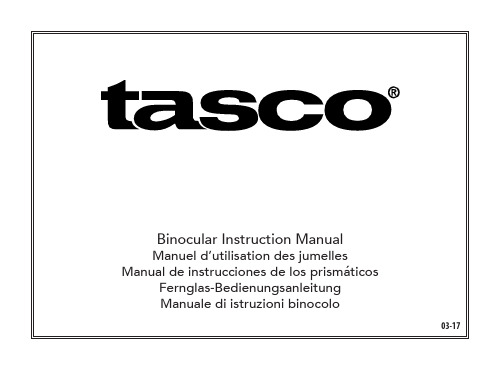
Diopter Setting
brick wall, tree branches, etc.) until it appears as sharp as possible.
6. Uncover the objective lens on the diopter side, cover the other objective lens, then view the same object.
Fig. 1
Roll-Down Eyecups Fig. 2
Interpupillary Distance 3
DIOPTER ADJUSTMENT AND FOCUSING
Fig. 3
1. Adjust eyecups interpupillary distance as described in the previous sections.
7. Using the diopter adjustment ring, focus the image for the eye on that side. Caution should be used as over turning or forcing
the diopter ring can cause damage or cause the eyepiece to break away from the chassis.
tree branches, etc.). 3. Adjust your binocular for individual eye strength using the diopter adjustment
Zoom Lever
ring as outlined in the instructions for “DIOPTER ADJUSTMENT AND FOCUSING”.
验光调节幅度负镜操作方法
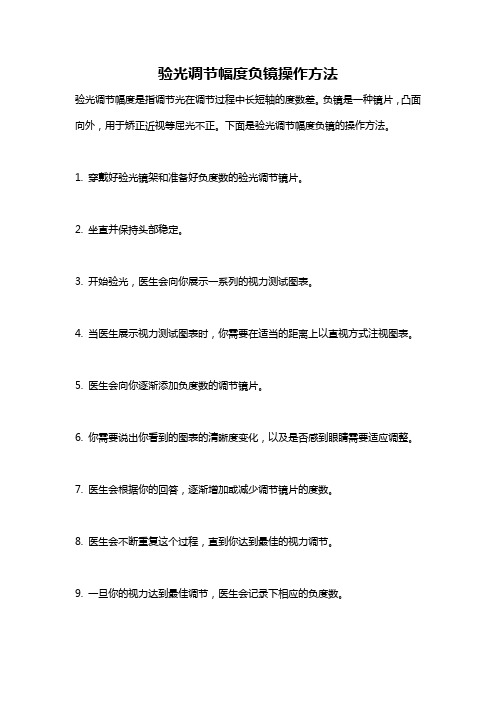
验光调节幅度负镜操作方法
验光调节幅度是指调节光在调节过程中长短轴的度数差。
负镜是一种镜片,凸面向外,用于矫正近视等屈光不正。
下面是验光调节幅度负镜的操作方法。
1. 穿戴好验光镜架和准备好负度数的验光调节镜片。
2. 坐直并保持头部稳定。
3. 开始验光,医生会向你展示一系列的视力测试图表。
4. 当医生展示视力测试图表时,你需要在适当的距离上以直视方式注视图表。
5. 医生会向你逐渐添加负度数的调节镜片。
6. 你需要说出你看到的图表的清晰度变化,以及是否感到眼睛需要适应调整。
7. 医生会根据你的回答,逐渐增加或减少调节镜片的度数。
8. 医生会不断重复这个过程,直到你达到最佳的视力调节。
9. 一旦你的视力达到最佳调节,医生会记录下相应的负度数。
请注意,这个操作方法只是一般指导,实际的验光调节过程可能会因人而异。
在进行验光调节之前,最好咨询专业验光师或眼科医生的建议。
近 视 回 归 镜
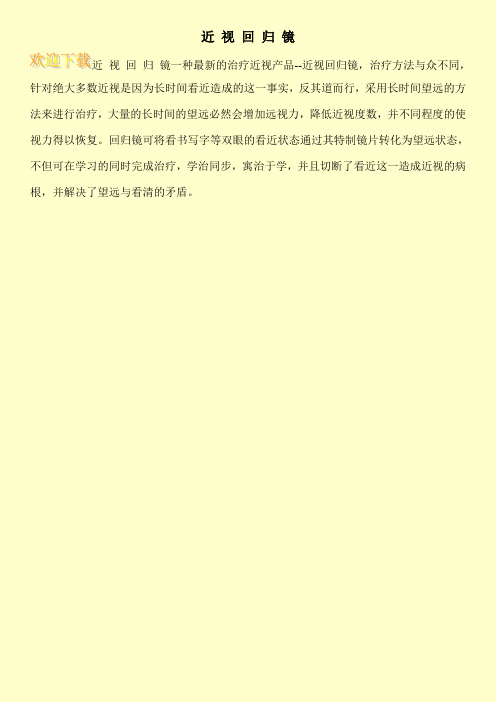
近视回归镜
近视回归镜一种最新的治疗近视产品--近视回归镜,治疗方法与众不同,针对绝大多数近视是因为长时间看近造成的这一事实,反其道而行,采用长时间望远的方法来进行治疗,大量的长时间的望远必然会增加远视力,降低近视度数,并不同程度的使视力得以恢复。
回归镜可将看书写字等双眼的看近状态通过其特制镜片转化为望远状态,不但可在学习的同时完成治疗,学治同步,寓治于学,并且切断了看近这一造成近视的病根,并解决了望远与看清的矛盾。
3B S CIENTIFIC 逆转眼镜说明书
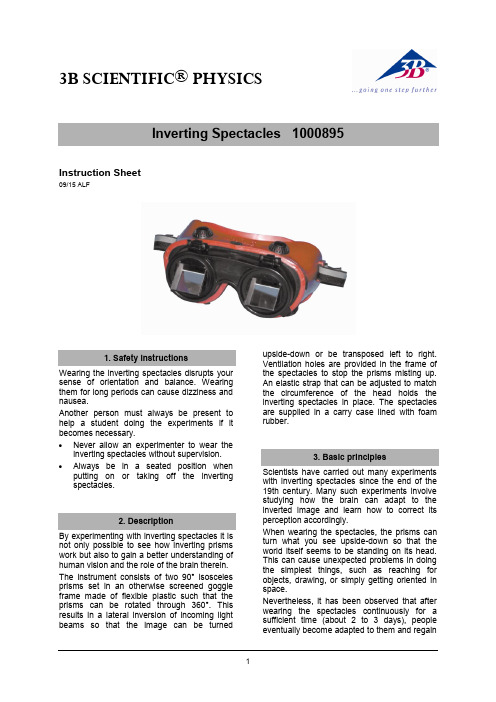
3B SCIENTIFIC ® PHYSICS1Instruction Sheet09/15 ALFWearing the inverting spectacles disrupts your sense of orientation and balance. Wearing them for long periods can cause dizziness and nausea.Another person must always be present to help a student doing the experiments if it becomes necessary.∙ Never allow an experimenter to wear theinverting spectacles without supervision. ∙ Always be in a seated position whenputting on or taking off the invertingspectacles. By experimenting with inverting spectacles it is not only possible to see how inverting prisms work but also to gain a better understanding of human vision and the role of the brain therein. The instrument consists of two 90° isosceles prisms set in an otherwise screened goggle frame made of flexible plastic such that the prisms can be rotated through 360°. This results in a lateral inversion of incoming light beams so that the image can be turnedupside-down or be transposed left to right. Ventilation holes are provided in the frame of the spectacles to stop the prisms misting up. An elastic strap that can be adjusted to match the circumference of the head holds the inverting spectacles in place. The spectacles are supplied in a carry case lined withfoam rubber. Scientists have carried out many experiments with inverting spectacles since the end of the 19th century. Many such experiments involve studying how the brain can adapt to the inverted image and learn how to correct its perception accordingly.When wearing the spectacles, the prisms can turn what you see upside-down so that the world itself seems to be standing on its head. This can cause unexpected problems in doing the simplest things, such as reaching for objects, drawing, or simply getting oriented in space.Nevertheless, it has been observed that after wearing the spectacles continuously for a sufficient time (about 2 to 3 days), people eventually become adapted to them and regain3B Scientific GmbH ▪ Rudorffweg 8 ▪ 21031 Hamburg ▪ Deutschland ▪ Technische Änderungen vorbehalten © Copyright 2015 3B Scientific GmbHthe ability to deal with things normally. Their view of the world rotates back into its normal position so that up is once again up and down is back to being down. Experimenters then see things exactly the same as before putting on the inverting spectacles. This indicates that the link between the sensing cells of the retina and the region of the brain that processes optical information is not fixed at birth but is formed by a learning process.If the spectacles are then removed after being worn for a long time, the world appears upside-down again. However, perception then returns to normal relatively quickly.∙When adjusting the prisms, do not touch the glass surfaces.∙Ensure that the prisms are set parallel toeach other.Adjusting the prisms:To make the image appear upside-down, set the prisms as shown above (side view of spectacles)To invert the image right to left, set the prisms as shown above (top view of spectacles)Should the prisms loosen in the frame after a while, tip the frame forward and tighten the securing ring.1. Drawing and writing on a blackboard2. Reading “mirror writing”3. Seeing, grasping and balancing objects4. Throwing and catching a ball5. Fill a container with water and pour water into another container∙ To clean use a soft damp cloth.∙Only use mild cleaning agents that do not contain alcohol or solvents.。
BSCOPE 单眼、双眼和三眼微观镜产品说明书
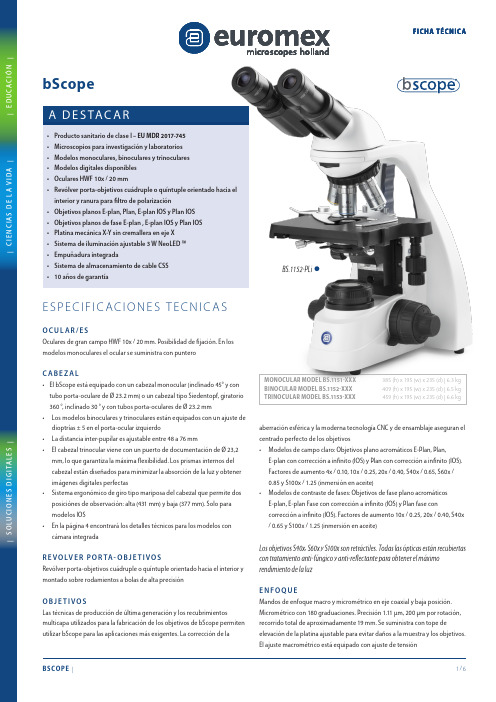
MONOCULAR MODEL BS.1151-XXX385 (h) x 195 (w) x 235 (d) | 6.3 kg BINOCULAR MODEL BS.1152-XXX 409 (h) x 195 (w) x 235 (d) | 6.5 kg TRINOCULAR MODEL BS.1153-XXX 459 (h) x 195 (w) x 235 (d) | 6.6 kgBS.1152-PLievólver porta-objetivos cuádruple o quíntuple orientado hacia el A SOculares de gran campo HWF 10x / 20 mm. Posibilidad de fijación. En los l bScope está equipado con un cabezal monocular (inclinado 45° y con tubo porta-oculare de Ø 23.2 mm) o un cabezal tipo Siedentopf, giratorioE mpuñadura para transporteBS.1151-EPL BS.1152-PLiBS.1153-PLPHiBS.1157-EPLi409 (h) x 195 (w) x 235 (d) | 7.1 kg BS.1157-PLiI C A SLos microscopios digitales bScope están equipados con una cámara CMOS de 5.1 MP 1/2.5 pulgadas USB-2.0, profundidad de color de 24 bits, 7 cuadros por segundo (2592 x 1944 píxeles) o 27 cuadros por segundo (1280 x 960 píxeles). El rango dinámico es de 76 db y relación señal/ruido 41 db. Se suministra con el software ImageFocus Alpha, cable USB-2.0 y un patrón de calibración deEl software ImageFocus Alpha de captura y análisis permite guardarimágenes en formatos .jpg, .tif, .bmp o .dicom, así como videos en formato.avi. Las mediciones y las anotaciones se pueden hacer en imágenes envivo o capturadas. Compatible con Windows 7, 8 y 10, configuraciones de| S O L U C I O N E S D I G I T A L E S || E D U C A C I ÓN || C I E N C I A S D E L A V I D A |FIC HA T ÉC NI C AA CC E S O R I O S PA R A CO N T R A S T E D E FA S EBS.9118 C ondensador Zernike para contraste de fase compuesto poranillos de fase para objetivos 10x/20x/40x/100x y posición para observación de campo claro, objetivos E-plan EPLPH 10/20/S40 (retráctil) y S100 (retráctil/inmersión en aceite), ocular telescópico para alineación de fases y filtro verdeBS.9120 C ondensador Zernike para contraste de fase compuesto poranillos de fase para objetivos 10x/20x/40x/100x y posición para observación de campo claro, objetivos con corrección a infinito (IOS) E-plan EPLPHi 10/20/S40 (retráctil) y S100 (retráctil/inmersión en aceite), ocular telescópico para alineación de fases y filtro verdeBS.9123 C ondensador Zernike para contraste de fase compuesto poranillos de fase para objetivos 10x/20x/40x/100x y posición para observación de campo claro, objetivos Plan PLPH 10/20/S40 (retráctil) y S100 (retráctil/inmersión en aceite), ocular telescópico para alineación de fases y filtro verdeBS.9126 C ondensador Zernike para contraste de fase compuesto poranillos de fase para objetivos 10x/20x/40x/100x y posición para observación de campo claro, objetivos con corrección a infinito (IOS) Plan PLPHi 10/20/S40 (retráctil) y S100 (retráctil/inmersión en aceite), ocular telescópico para alineación de fases y filtro verdeBS.9148 O cular telescópico de centrado de fases, por bScope IOS(objetivo corregido a infinito) con tubos de 30 mmBS.9149 O cular telescópico de centrado de fases,por bScope non-IOS (objetivo con corrección finita) con tubos de 23.2 mmBS.9156 K it de contraste de fase para condensador de Abbe con ranurapara laminas. Compuesto por objetivos de fase E-plan EPLPH 10x/S40x (retráctil), lamina con anillos de fase 10x y 40x, ocular telescópico para alineación de fases y filtro verdeBS.9157 K it de contraste de fase para condensador de Abbe con ranurapara laminas. Compuesto por objetivos de fase E-plan EPLPH 20x/S100x (retráctil/inmersión en aceite), lamina con anillos de fase 20x y 100x, ocular telescópico para alineación de fases y filtro verdeBS.9158 K it de contraste de fase para condensador de Abbe con ranurapara laminas. Compuesto por objetivos de fase corregidos a infinito (IOS) E-plan EPLPHi 10x/S40x (retráctil), lamina con anillos de fase 10x y 40x, ocular telescópico para alineación de fases y filtro verdeBS.9159 K it de contraste de fase para condensador de Abbe con ranurapara laminas. Compuesto por objetivos de fase corregidos a infinito (IOS) E-plan EPLPHi 20x/S100x (retráctil/inmersión en aceite), lamina con anillos de fase 20x y 100x, ocular telescópico para alineación de fases y filtro verdeBS.9162 K it de contraste de fase para condensador de Abbe con ranurapara laminas. Compuesto por objetivos de fase corregidos a infinito (IOS) Plan PLPHi 10x/S40x (retráctil), lamina con anillos de fase 10x y 40x, ocular telescópico para alineación de fases y filtro verdeBS.7220 Objetivo Plan PL 20x/0.40. DT 8.6 mm BS.7240 Objetivo Plan PL S40x/0.65. DT 0.56 mm BS.7260 Objetivo Plan PL S60x/0.85. DT 0.25 mmBS.7200 Objetivo Plan PL S100x/1.25 (retráctil/inmersión en aceite) DT 0.33 mm BS.7510 Objetivo E-Plan Phase EPLPH 10x/0.25. DT 6.61 mmBS.7520 Objetivo E-Plan Phase EPLPH 20x/0.40. DT 1.85 mmBS.7540 Objetivo E-Plan Phase EPLPH S40x/0.65 (retráctil). DT 0.64 mm BS.7500 O bjetivo E-Plan Phase EPLPH S100x/1.25 (retráctil/inmersión enaceite). DT 0.19 mmBS.8204 O bjetivo corregido a infinito (IOS) E-plan EPLi 4x/0.10. DT 18.9 mm BS.8210 Objetivo corregido a infinito (IOS) E-plan EPLi 10x/0.25. DT 5.95 mm BS.8220 Objetivo corregido a infinito (IOS) E-plan EPLi 20x/0.40. DT 2.61 mm BS.8240 O bjetivo corregido a infinito (IOS) E-plan EPLi S40x/0.65(retráctil). DT 0.78 mmBS.8200 O bjetivo corregido a infinito (IOS) E-plan EPLi S100x/1.25(retráctil/inmersión en aceite). DT 0.36 mmBS.8404 Objetivo corregido a infinito (IOS) Plan PLi 4x/0.10. DT 21.0 mm BS.8410 Objetivo corregido a infinito (IOS) Plan PLi 10x/0.25. DT 5.0 mm BS.8420 Objetivo corregido a infinito (IOS) Plan PLi 20x/0.40. DT 8.8 mm BS.8440 O bjetivo corregido a infinito (IOS) Plan PLi S40x/0.65 (retráctil).DT 0.66 mmBS.8460 O bjetivo corregido a infinito (IOS) Plan PLi S60x/0.85 (retráctil).DT 0.46 mmBS.8400 O bjetivo corregido a infinito (IOS) Plan PLi S100x/1.25(retráctil/inmersión en aceite). DT 0.36 mmBS.8510 O bjetivo corregido a infinito (IOS) E-Plan Phase EPLPHi 10x/0.25.DT 5.95 mmBS.8520 O bjetivo corregido a infinito (IOS) E-Plan Phase EPLPHi 20x/0.40.DT 2.61 mmBS.8540 O bjetivo corregido a infinito (IOS) E-Plan Phase EPLPHi S40x/0.65(retráctil). DT 0.78 mmBS.8500 O bjetivo corregido a infinito (IOS) E-Plan Phase EPLPHiS100x/1.25 (retráctil/inmersión en aceite). DT 0.36 mmBS.8710 O bjetivo corregido a infinito (IOS) Plan Phase PLPHi 10x/0.25.DT 5.00 mmBS.8720 O bjetivo corregido a infinito (IOS) Plan Phase PLPHi 20x/0.40.DT 8.80 mmBS.8740 O bjetivo corregido a infinito (IOS) Plan Phase PLPHi S40x/0.65(retráctil). DT 0.66 mmBS.8700 O bjetivo corregido a infinito (IOS) Plan Phase PLPHi S100x/1.25(retráctil/inmersión en aceite). DT 0.36 mmCO N D E N S A D O R E S Y A CC E S O R I OSBS.9102 C ondensador de Abbe N.A. 1.25 con ranura para laminasopcionales de campo oscuro (máximo 400x) y contraste de faseBS.9170 L amina con campo oscuro (máximo 400x) para condensadorde Abbe con ranura para bScope. Requiere condensador con ranura ((BS.9102)BS.9105 Condensador Abbe de lente abatible N.A. 0.9/1.25EuromexMicroscopenbv•Papenkamp20•6836BDArnhem•TheNetherlands•T+31(0)263232211•****************•AE.9919AE.9916BS.1153-PLicon cámara。
HE407K-GR X2 反射瞄准镜 用户手册说明书

12User's ManualFig 1 HE407K-GR X2 Reflex sightFig 46.3.Battery Replacement(Fig4):a. Removing the battery :I. Remove the battery tray screw.ii. Use the included tool asa lever in the battery tray1) Ultra compact size for concealed carry applications.2) 6MOA Dot.TM 3) Shake Awake - Motion on with last setting recall.4) Parallax free, unlimited eye relief. 5) CNC milled 7075 Aluminum Housing.6) 10 day light and 2 night vision compatible brightness settings.7) Window Size 0.58x0.77 inches.8) IP67 Certified.Fig2A canted objective lens is part of the design ofreflex/reflective optical sights. In order to create a proper reflection of the reticle/dot the objective lens must beperpendicular to the LED. Because the LED is mounted to the side of the internal tube the objective lens will be canted in that direction.slots to remove the battery tray and battery.b. Battery installation :I. Insert the battery into the battery tray with the POSITIVE side facing DOWN.ii. Insert and press the tray into the battery compartment.iii. Tighten the battery tray screw.Caution:The loss or damage of the seal ring may cause water to leak into the compartment which could damage the product.Thank you for purchasing the HOLOSUN HE407K-GR X2 Open Reflex sight. This open reflex sight is sized for use on either a pistol or rifle. The stream lined design and compact sizemake it the ideal sight for concealed carry. Before operation, please read the User's Manual carefully.NOTE: HE407K-GR is compatible with some standard mounting solutions currently available. For a footprint drawing, contact Holosun.1. Place the HE407K-GR on a compatible slide cut or adapter plate (this varies based on your slide configuration).2. Use either the included screws or screws supplied with your slide or from your gunsmith and tighten to 15 INCH/lbs using a non-permanent (medium/blue) thread locker. (Fig5)3. Verify proper clearances and firearm function prior to use.1. One high quality CR1632 Lithium battery is included with purchase.Caution: Do not use a rechargeable battery.2. A high quality battery can power this device for up toFig 56 MOA DotHE407K-GR34Fig 61.Switch on: Press and release either brightness button ("+"or"-") to turn on the sight, See Fig 6.2.Power off: Press the"+"and"-" buttons simultaneously to turn the power and motion sensor off (this will disable Shake Awake).3.Operation mode: Two modes are available in the following order: Manual Mode -> Lockout Mode.1) Manual mode:Brightness adjustment: There are 12 reticle brightness setting levels in manual mode. Settings 1 and 2 are NVcompatible and setting 12 is the brightest. Press ”+” or ”-” to increase or decrease the brightness.2) Lockout Mode:Lock Mode Activation: Hold the “+” button for 3 seconds (until the LED blinks once) to activate Lock Mode. In lock mode buttons are locked out preventing any setting changes.To deactivate Lock Mode, hold the “+” button for 3 seconds , the LED will blink once to confirm Lock Mode is deactivated.4. Sleep time setting:1) Please note that your red dot will automatically enter into sleep mode after 10 minutes of no movement.2) The sight will instantaneously wake up and turn on with any motion detection to last saved settings.3) The default sleep timer setting is 10 min, but can be adjusted.i. Press and hold the “+” button for 10 seconds to enter time adjustment mode. There are 4 options: 10 min, 1h, 12h or the sleep mode is disabled.ii. Press and release either “+” or “-” button to set the time.The LED will blink (1=10 min, 2=1h, 3=12h, or 4=disable sleep mode).iii. Press the “+” and “-” buttons simultaneously to save the time setting and power off the sight.5. Note:1) Memory function: The sight will remember the last saved brightness setting when powered on and off.2) Low battery Warning: If the battery voltage is below 2.2Vdc, the reticle will blink slowly.Caution: If you feel the knobs can no longer be rotated, you may have reached the mechanical limit of the adjustment turret. Do not try to rotate the knobs further if you feel a bind or you may cause damage.Fig 75) The maximum adjustment range is ±30MOA.HE407K-GR X2Reflex SightWe provide a limited lifetime warranty from the date of purchase on parts and workmanship to the originalpurchaser. At our sole discretion, we will repair or replace products found to be defective under normal use without charge, excluding any delivery costs, which will be born by purchaser. We will not be liable for incidental,consequential, or special damages arising out of or in any connection with the use or performance of this product. This warranty is void if the product has been misused, modified, neglected, or disassembled prior to its return. Please refer to for current and complete warranty information and other conditions.This device is a precision instrument that deservesreasonably cautious care. The following tips are provided to ensure a long product life. The optical lenses are multicoated optical glass. When cleaning the lenses, blow away the dust on the surface, wet the lens with lens cleaner or clean water, then wipe away smudges with lens tissue, soft cotton or a microfiber cloth. Avoid touching the glass surface with dry cloth or tissue paper. Do not use organic solvents such as alcohol or acetone. No special maintenance is needed for the housing surface. Do not try to dismantle the device as the internal parts are specially cleaned and sealed and with an anti-fog treatment. Any such attempt will void the warranty.Included Tool:1. Flat tipped end is used to adjust the Windage & Elevation.2. T10 Torx tool for screws.Fig 81) The sight has been factory zeroed to approximately 25 yards and should require minimal adjustment to achieve zero.2) The Elevation adjustment is located on the rear section of the housing and the Windage adjustment is located on the right side of the housing.3) Adjustment can be performed by inserting the flat tipped end of the included tool into the turret slot and rotating, See Fig 7.4) Each adjustment click has a value of approximately 1 MOA or 1 inch at 100 yards (1/2" at 50y; 1/4" at 25y). When zeroing at 25 yard, if your impacts are 2 inches low and 1 inch right, you will need to adjust Elevation 8 clicksUP(counterclockwise) and 4 clicks LEFT (clockwise)Phone: (909) 594-2888Fax: (909) 598-4888E-mail:********************Ver:A0Windage AdjustmentElevationAdjustmentBrightness increaseBrightness decrease②①。
视力训练—近视控制镜操作手册
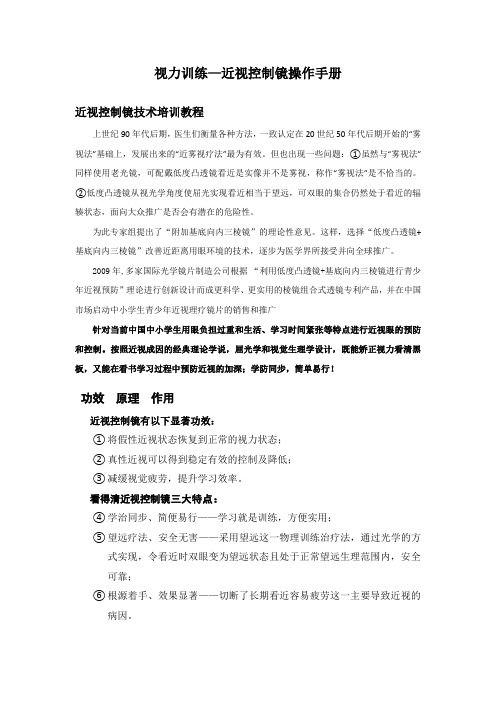
视力训练—近视控制镜操作手册近视控制镜技术培训教程上世纪90年代后期,医生们衡量各种方法,一致认定在20世纪50年代后期开始的“雾视法”基础上,发展出来的“近雾视疗法”最为有效。
但也出现一些问题:①虽然与“雾视法”同样使用老光镜,可配戴低度凸透镜看近是实像并不是雾视,称作“雾视法”是不恰当的。
②低度凸透镜从视光学角度使屈光实现看近相当于望远,可双眼的集合仍然处于看近的辐辏状态,面向大众推广是否会有潜在的危险性。
为此专家组提出了“附加基底向内三棱镜”的理论性意见。
这样,选择“低度凸透镜+基底向内三棱镜”改善近距离用眼环境的技术,逐步为医学界所接受并向全球推广。
2009年,多家国际光学镜片制造公司根据“利用低度凸透镜+基底向内三棱镜进行青少年近视预防”理论进行创新设计而成更科学、更实用的棱镜组合式透镜专利产品,并在中国市场启动中小学生青少年近视理疗镜片的销售和推广针对当前中国中小学生用眼负担过重和生活、学习时间紧张等特点进行近视眼的预防和控制。
按照近视成因的经典理论学说,屈光学和视觉生理学设计,既能矫正视力看清黑板,又能在看书学习过程中预防近视的加深;学防同步,简单易行!功效原理作用近视控制镜有以下显著功效:①将假性近视状态恢复到正常的视力状态;②真性近视可以得到稳定有效的控制及降低;③减缓视觉疲劳,提升学习效率。
看得清近视控制镜三大特点:④学治同步、简便易行——学习就是训练,方便实用;⑤望远疗法、安全无害——采用望远这一物理训练治疗法,通过光学的方式实现,令看近时双眼变为望远状态且处于正常望远生理范围内,安全可靠;⑥根源着手、效果显著——切断了长期看近容易疲劳这一主要导致近视的病因。
看得清近视控制镜作用医理:看得清近视控制镜是高科技特殊材料合成的、具有五层结构模式的“棱镜式组合透镜”。
看得清近视控制镜杰出的功能亦源于其五层结构模式:第1 光量子层:透过镜片上特有的光量子涂层活跃视网膜黄斑区域的视觉细胞的敏感性(光敏感层,可增加光敏感度25% 以上)。
近视矫正仪

一、近视矫正仪近视矫正仪也称为视力优化仪、直线训练仪、视功能训练仪等,是一般的近视矫正中心所采用的核心仪器,是系统训练所必须的。
二、近视矫正仪结构特点三、近视矫正仪功能及原理(一)功能1、基本防近视功能(1)抵消看近“后离焦”即近视发病第一关键环节:通过牛眼换远视片,抵消看近,并阻断近视第一关键环节:视网膜周边“后离焦”。
A手动转牛眼上镜片,可转出远视雾化镜,造成远视化雾视或前离焦状态,促进眼内肌过度松驰,晶状体变扁,从而提高远视力。
B自动变焦,可产生渐进增加的300到500度远视雾化,可显著提高远视力。
(2)抵消看近“后调焦”即近视发病第二关键环节:提供调节-集合灵敏度训练,提高眼调节灵敏度,从而阻断近视第二关键环节“后调焦”(即调节滞后)。
近视眼长期看近,晶状体焦点将“凝固”在近处,可导致看远时不能放松变远,导致远视力下降。
2、强化防近视功能(1)视野扩大训练,抵消看近形觉剥夺性近视,从而强化防近视作用(看近时,看得越近,视野越小,形觉剥夺越严重,越易引起近视)。
(2)耳穴电针灸剌激:通过经络刺激,活化眼属耳穴,强化防近视作用。
(二)原理◆1、1条线调节—集合灵敏度训练,提高看远的调焦灵敏度而提高远视力;◆2、2种视细胞敏感性提高:即视网膜及视中枢视细胞敏感性提高而增加视力;◆3、3种对比度视力训练:•(1)视网膜RGY三种视觉细胞敏感性刺激;•(2)CAM仪视觉中枢敏感性刺激,提高视觉细胞敏感性;•(3)其它增视训练(红闪、光刷、精细视力等)。
•参考资料:中华近视网。
